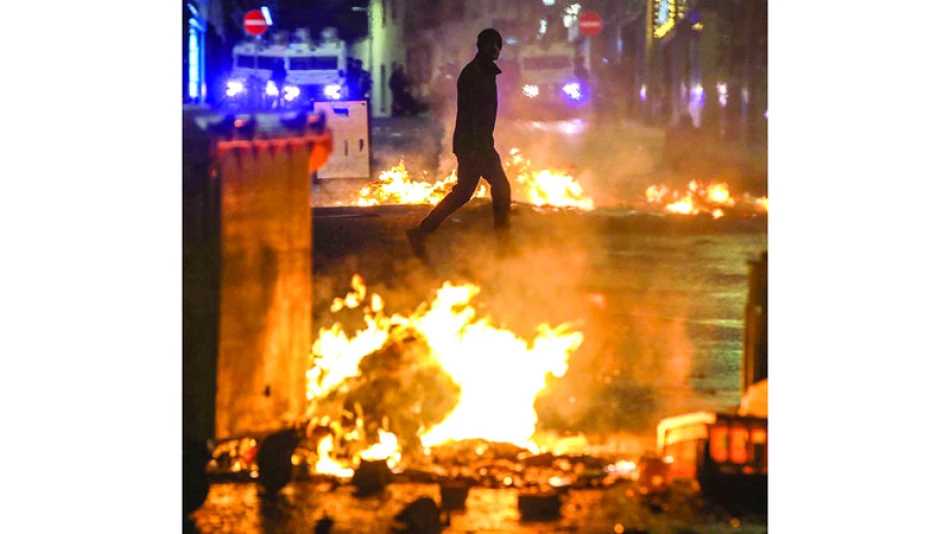
Northern Ireland Turmoil: Anti-Immigrant Tensions Revive Echoes of the Troubles
Northern Ireland's Anti-Immigrant Violence Echoes Darkest Chapters of The Troubles
Northern Ireland is experiencing its worst anti-immigrant violence in decades, with arson attacks forcing 21 families from their homes across multiple towns. The systematic use of fire to terrorize migrants mirrors tactics employed during The Troubles, revealing how deeply embedded sectarian mechanisms can rapidly pivot toward new targets. While the religious divide that fueled decades of conflict has largely stabilized, the infrastructure of intimidation remains intact—and immigrants have become the latest victims.
The Ballymena Spark That Ignited Regional Violence
The current wave of violence began in Ballymena, a Protestant stronghold 48 kilometers from Belfast, following allegations against two 14-year-old Romanian boys accused of attempted rape on June 7. Both teens, who required a Romanian interpreter in court according to the BBC, denied the charges.
What started as a peaceful protest the night after their court appearance rapidly escalated into six consecutive nights of rioting. Masked gangs torched homes belonging to immigrant families, while similar attacks spread to Larne and Portadown. In Larne, rioters burned down a recreational center being used as temporary shelter for displaced persons.
The geographic pattern is telling. Duncan Morrow, a political science professor at Ulster University, notes that "territoriality in Northern Ireland is still entrenched and guarded by armed groups that still exist." The rapid escalation reflects a society where violence remains an embedded organizational tool.
Historical Parallels: From Catholics to Immigrants
The current attacks bear striking similarities to August 1969, when loyalist crowds burned Catholic homes in Belfast and Derry, forcing thousands to flee. Professor Dominic Bryan from Queen's University Belfast, a conflict specialist, observes that "the geography of the current conflict is similar to what it was in 1969, when there were scattered Catholics living in the streets."
Near the charred homes in Ballymena sits the former site of a Catholic primary school, burned in a 2005 sectarian attack. The nearby Our Lady of Harville Catholic church, also destroyed by arson, serves as a physical reminder of how fire has long been weaponized against perceived outsiders.
The key difference today is the target. Bryan explains: "Nowadays, it's clear that immigrant families are the obvious targets as a minority in northern streets that were previously largely homogeneous. They have become completely exposed."
The Criminal-Paramilitary Nexus
The violence isn't simply spontaneous community anger. Police believe both loyalist and republican paramilitary groups have facilitated anti-immigrant attacks across Northern Ireland and the Republic of Ireland. Ballymena remains a stronghold for dissident paramilitary groups, some of which have reorganized as criminal gangs.
Court cases suggest the town also serves as a base for Romanian organized crime groups involved in drug trafficking—a dynamic that adds layers of complexity to community tensions. Much of the recent rioting was organized online, where some loyalist factions have adopted far-right, anti-immigrant rhetoric.
This represents a significant evolution. During The Troubles, violence had clear political objectives around constitutional status. Today's attacks lack such coherent goals, making them potentially more unpredictable and harder to resolve through political accommodation.
Symbolic Politics: "Stop the Boats" Meets Orange Tradition
The ideological fusion became explicit during July 12 celebrations, when unionists traditionally commemorate a Protestant king's victory over a Catholic monarch. This year, bonfires included a mock immigrant boat with signs reading "Stop the Boats" and "Veterans Before Refugees."
This borrowing of British far-right slogans reveals how local grievances are increasingly connected to broader anti-immigration movements. Ballymena, historically home to hardline Protestant politics, provides fertile ground for such messaging.
The timing is significant. Northern Ireland remains the UK's least diverse region by a wide margin, making demographic change particularly visible in working-class communities where many immigrant families settle. For communities that historically experienced emigration rather than immigration, the reversal represents a profound shift.
A Society Still Primed for Conflict
Walking through Ballymena's Clonavon Terrace—the intersection between traditional Protestant and Catholic areas—reveals a community on edge. UK and Ulster flags adorn every surface, while residents immediately challenge strangers about their identity and purpose.
This hypervigilance reflects what experts describe as a society where conflict mechanisms remain readily activated. The infrastructure of division—territorial marking, community policing by paramilitaries, and rapid mobilization for violence—can quickly redirect toward new targets.
Democratic Unionist Party assembly member Jonathan Buckley captured the tension, acknowledging "serious concerns about uncontrolled immigration, even illegal immigration," while condemning violence as "absolutely intolerable." This reflects the broader challenge: legitimate policy debates about immigration occurring within a framework where violence remains a normalized response.
Self-Defeating Destruction
The attacks have expanded beyond immigrant homes to infrastructure, including a mobile phone tower in Belfast. West Belfast MP Paul Maskey condemned such actions as "self-destructive" and "ultimately self-defeating," noting they "amount to an attack on the entire community."
This pattern suggests the violence may be driven more by opportunity and embedded behavioral patterns than strategic thinking. The destruction of communications infrastructure particularly highlights how current attacks lack the political coherence that characterized Troubles-era violence.
While the vast majority of Northern Ireland residents reject this violence, the events demonstrate how quickly dormant conflict mechanisms can reactivate. The region's hard-won peace remains vulnerable to exploitation by those seeking to channel economic frustration and demographic anxiety into familiar patterns of intimidation and territorial control.
The challenge for authorities is addressing legitimate concerns about rapid demographic change while preventing the normalization of violence as a community response—a balance that will likely define Northern Ireland's stability in the coming years.
 Sara Khaled
Sara Khaled







